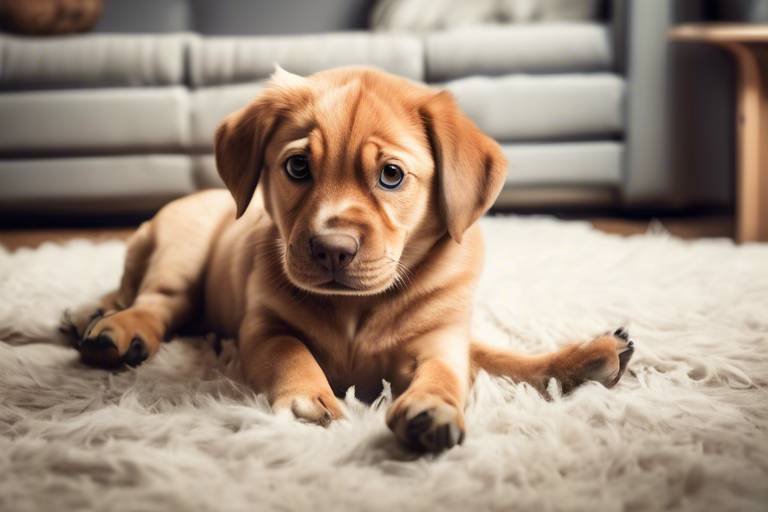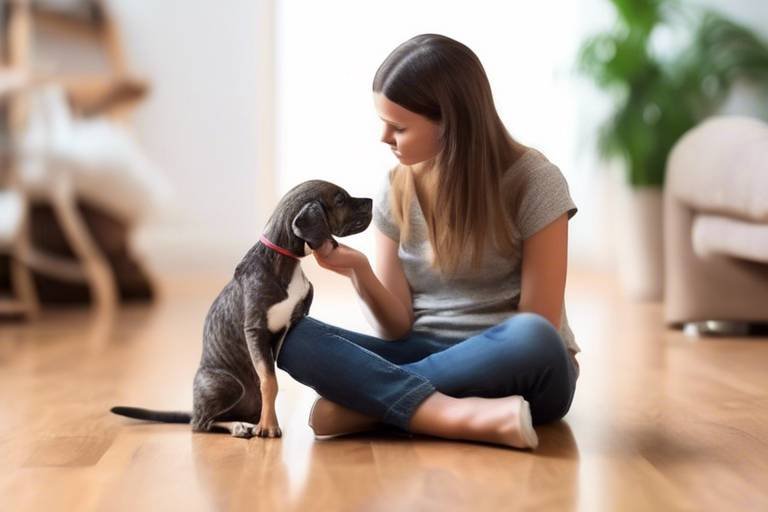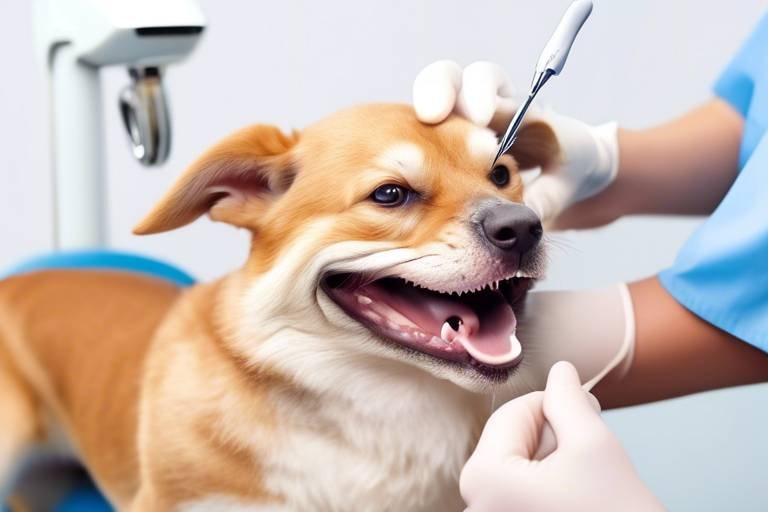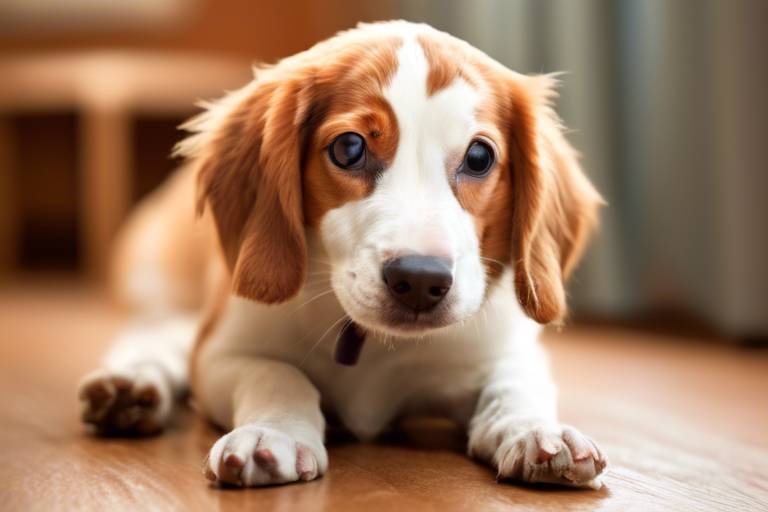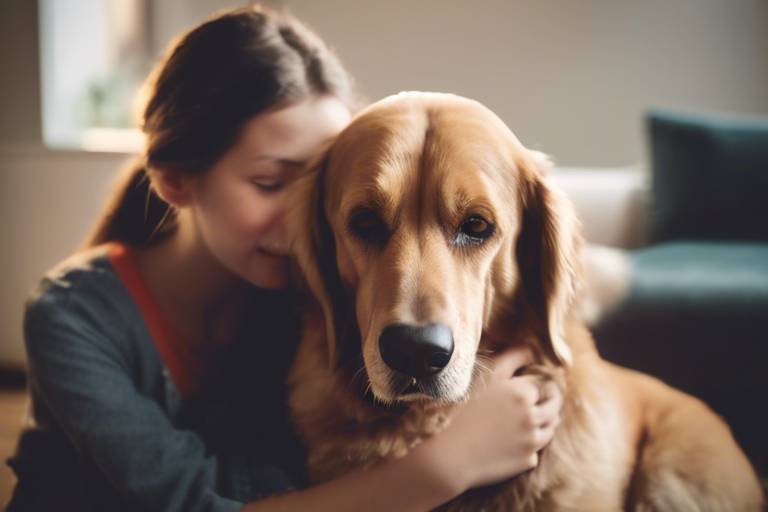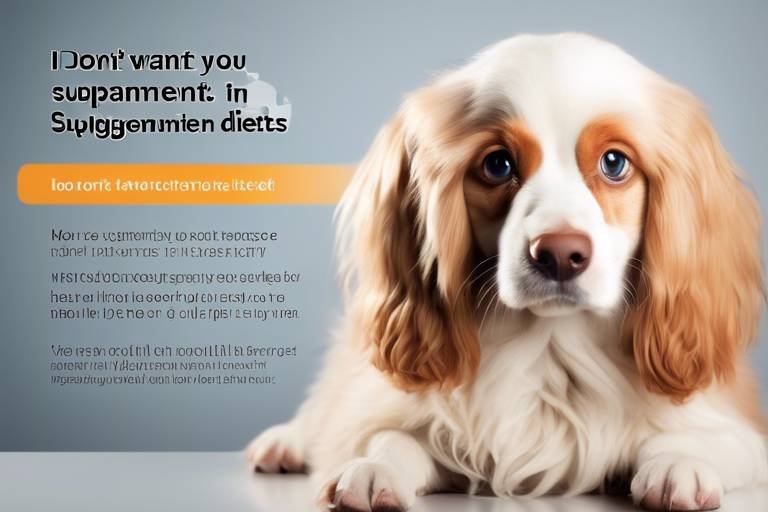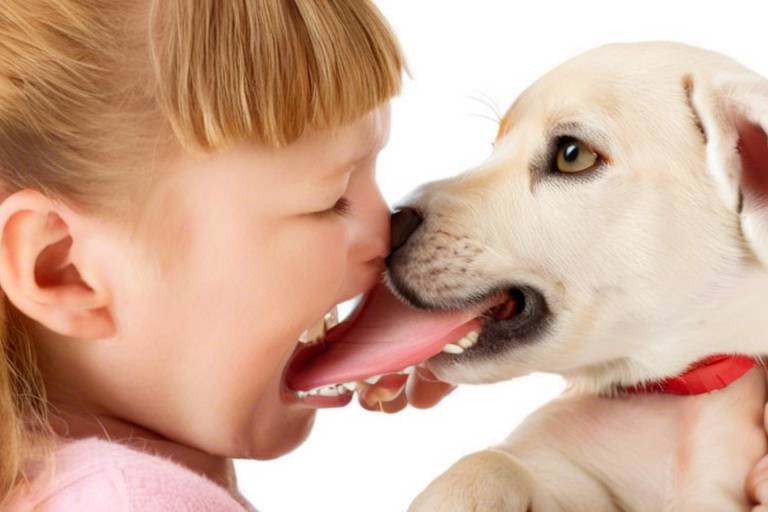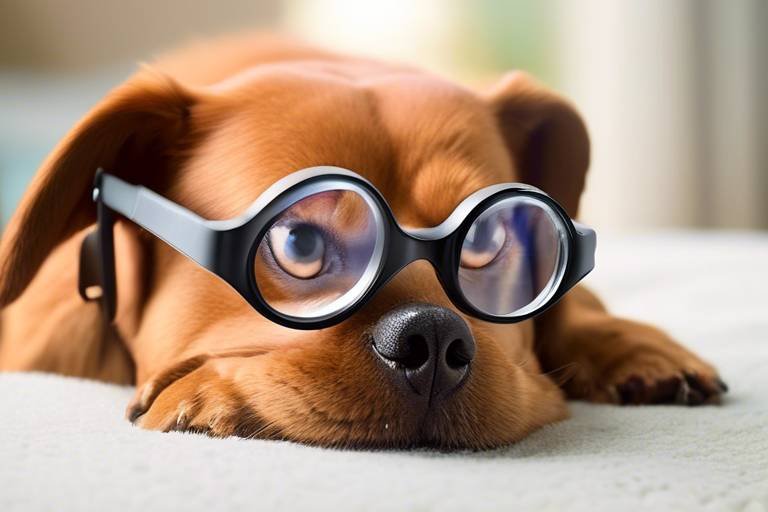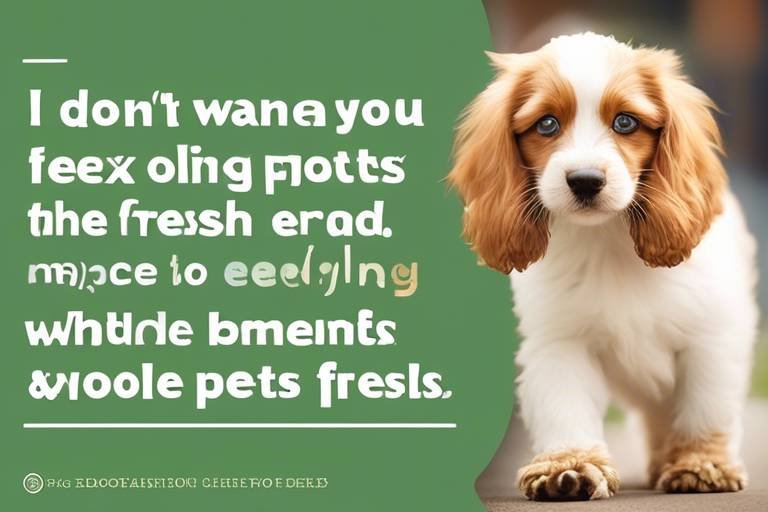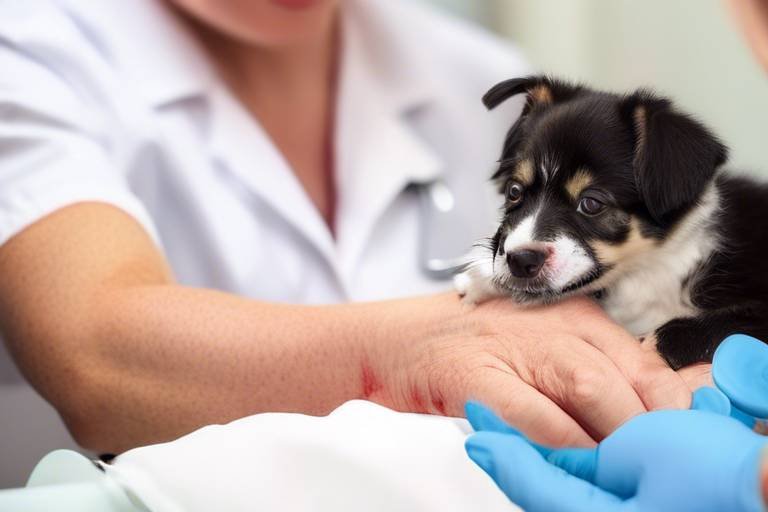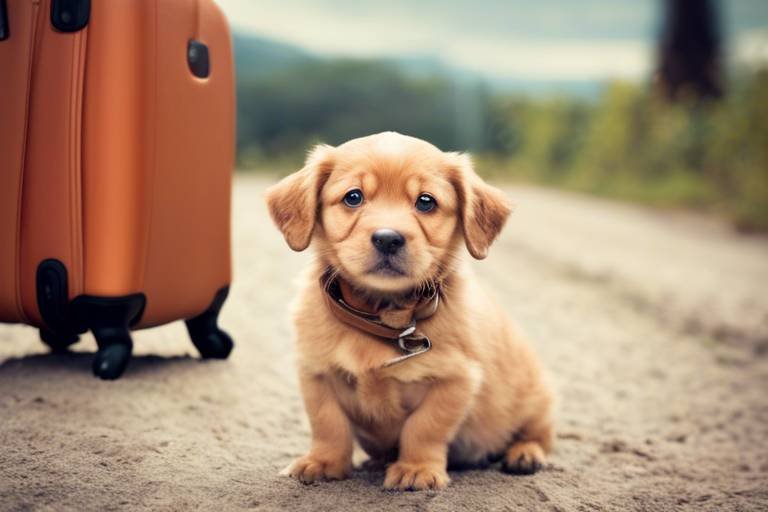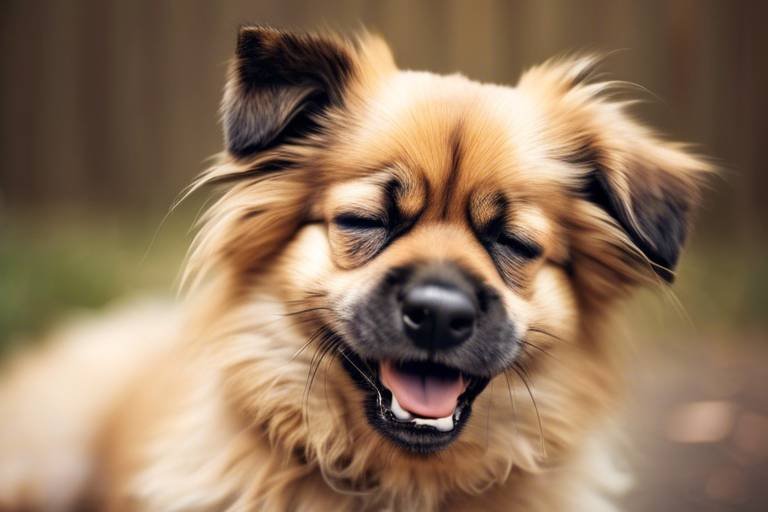How to Create a Safe Home Environment for Your Pets
Creating a safe home environment for your pets is not just a responsibility; it's a labor of love. Our furry friends depend on us to keep them out of harm's way, and with a few thoughtful adjustments, you can transform your living space into a haven for them. Imagine your home not only as a shelter but as a playground where your pets can roam freely without the constant worry of danger lurking around every corner. In this article, we’ll explore essential tips and strategies that will help you ensure your home is a secure space for your beloved companions.
First things first, understanding the potential risks in your home is key. Think about it: there are hidden dangers that might seem harmless to us but could pose serious threats to our pets. From toxic plants to household chemicals, being aware of these hazards is crucial in safeguarding your pets’ well-being. As pet owners, it’s our duty to identify and mitigate these risks, creating a safe sanctuary where our animals can thrive.
Next, let's dive into the world of pet-proofing techniques. This involves making necessary adjustments to your living space to minimize risks. For instance, securing furniture and removing harmful items from reach are practical steps that can dramatically improve your pet's safety. Have you ever seen a curious cat climb onto a high shelf? It’s both amusing and terrifying! By taking proactive measures, you can prevent these playful antics from turning into dangerous situations.
One of the most significant hazards in our homes is exposed electrical cords. These can be incredibly tempting for pets, especially for those who love to chew. To tackle this issue, consider using cord covers. These are fantastic solutions for safeguarding electrical wires while maintaining a tidy appearance. They come in various styles and materials, allowing you to choose one that matches your home decor. Additionally, organizing cables and wires can significantly reduce the risk of chewing and tangling. Think of it as decluttering your space not just for aesthetics but for safety!
Another critical aspect of pet-proofing is identifying toxic plants. Many common houseplants, such as lilies and philodendrons, can be harmful or even fatal to pets. It’s essential to know which plants to avoid and to consider alternatives that are safe for your furry companions. For example, spider plants and Boston ferns are beautiful and non-toxic options. By swapping out hazardous plants for safer varieties, you can add greenery to your home without compromising your pet's health.
Creating safe spaces for your pets is also vital. Designating specific areas in your home can enhance their safety and comfort. Think of a cozy corner with their bed, toys, and a little privacy, where they can retreat when they need some downtime. Choosing the right furniture can further contribute to a pet-friendly environment. Look for options that are durable, easy to clean, and safe for pets. Materials like microfiber and leather can withstand wear and tear while being simple to maintain.
Don't forget about the great outdoors! Designing a pet-friendly outdoor area is crucial for their safety. A secure fenced yard allows your pets to enjoy the fresh air and sunshine without the risk of wandering off. Make sure the fence is high enough and buried deep enough to prevent digging. You can also create a designated play area with toys and shade to keep them entertained and cool during those hot summer days.
In conclusion, creating a safe home environment for your pets requires a bit of effort, but the peace of mind it brings is worth it. By understanding potential risks, implementing pet-proofing techniques, and designing safe spaces, you can ensure that your home is a sanctuary for your furry friends. Remember, a happy pet is a safe pet!
- What are the most common household hazards for pets?
Common hazards include toxic plants, household chemicals, electrical cords, and small objects that can be swallowed.
- How can I pet-proof my home effectively?
Start by removing toxic plants, securing electrical cords, and ensuring small items are out of reach. Consider using cord covers and organizing cables.
- Are there any plants that are safe for pets?
Yes! Some pet-friendly plants include spider plants, Boston ferns, and bamboo palms.
- How can I create a safe outdoor space for my pets?
Ensure your yard is securely fenced, check for any hazardous plants, and provide shaded areas for them to relax.

Understanding Pet Safety Risks
When it comes to our furry friends, their safety should be our top priority. Understanding the common hazards lurking in our homes is crucial for keeping our pets safe and sound. From curious puppies to mischievous kittens, pets are naturally inclined to explore their surroundings, often leading them into dangerous situations. Did you know that many household items pose a significant risk to your pets? It's true! Everything from cleaning supplies to certain plants can be harmful, and being aware of these risks is the first step in creating a safe environment.
One of the most overlooked dangers is household chemicals. Many cleaning products, detergents, and even some personal care items contain toxic substances that can be harmful if ingested. For example, bleach and ammonia are common culprits that can lead to severe health issues in pets. It's essential to store these items in high cabinets or locked areas, out of reach of your curious companions. Additionally, always opt for pet-safe cleaning products whenever possible to minimize risks.
Another area to be mindful of is toxic plants. You might be surprised to learn that many popular houseplants are actually harmful to pets. Some common offenders include:
- Lilies
- Azaleas
- Philodendrons
- Dieffenbachia (Dumb Cane)
These plants can cause anything from mild stomach upset to severe poisoning. If you're a plant lover, consider replacing these with pet-friendly options like spider plants or Boston ferns, which can brighten your home without putting your pets at risk.
Moreover, small household items can also pose a choking hazard. Things like rubber bands, coins, and small toys should be kept out of your pet's reach. It's amazing how quickly a playful pet can turn a seemingly harmless object into a choking hazard! Regularly check your living space for any items that might have fallen to the ground and could be enticing to your pets.
Finally, don’t forget about the risks associated with food items. Certain human foods, such as chocolate, grapes, and onions, are toxic to pets. It's vital to educate yourself about what foods are safe and which are not. Keeping food stored securely and being mindful of what you leave out on counters can prevent accidental ingestion.
In summary, being aware of the potential dangers in your home is the first step to ensuring your pets are safe. By taking proactive measures to eliminate risks, you can create a secure environment where your pets can thrive. Remember, a little prevention goes a long way in keeping your furry family members happy and healthy!
Q: What are some common household items that are toxic to pets?
A: Common household items that can be toxic include cleaning products, certain plants (like lilies and azaleas), and some human foods (like chocolate and onions).
Q: How can I pet-proof my home effectively?
A: Start by securing hazardous items in cabinets, removing toxic plants, and keeping small objects out of reach. Regularly inspect your home for potential risks.
Q: Are there pet-safe cleaning products available?
A: Yes! Many brands offer cleaning products that are specifically formulated to be safe for pets. Look for these options when shopping for household cleaners.
Q: What should I do if my pet ingests something toxic?
A: If you suspect your pet has ingested a toxic substance, contact your veterinarian or an emergency animal clinic immediately for guidance.

Essential Pet-Proofing Techniques
When it comes to creating a safe haven for your furry friends, pet-proofing your home is a crucial step that cannot be overlooked. Just like you would baby-proof a house for a toddler, your pets deserve the same level of consideration to ensure they roam freely without encountering hidden dangers. The good news is that pet-proofing is not as daunting as it sounds. With a few thoughtful adjustments and some creativity, you can transform your living space into a pet-friendly paradise.
First things first, let’s talk about those pesky hazards that lurk in the corners of our homes. From sharp edges on furniture to small objects that can be swallowed, the list of potential risks is extensive. For instance, did you know that many common household items, like cleaning supplies and medications, can be toxic to pets? Taking the time to secure these items in cabinets or high shelves can make a world of difference. Additionally, consider investing in child-proof locks for cabinets to keep those curious paws at bay.
Another area that often gets overlooked is the furniture arrangement. Believe it or not, the way you position your furniture can either enhance or hinder your pet's safety. For example, if you have a coffee table with sharp corners, it might be worth considering a corner guard. Not only does this protect your pets from potential injuries, but it also gives you peace of mind knowing that your home is a safer space. Moreover, be mindful of any decorative items that could easily tip over; securing these items can prevent accidents.
Now, let’s dive into the nitty-gritty of organizing your space. A well-organized home is not only aesthetically pleasing but also significantly safer for your pets. For example, keeping your electrical cords tidy is essential. Exposed cords can be incredibly tempting for pets who love to chew. To tackle this issue, consider using cord covers or cable management solutions. These not only hide the cords but also keep them out of reach, preventing any potential hazards. Below is a simple table summarizing some effective cord management solutions:
| Solution | Description |
|---|---|
| Cord Covers | Protective tubes that encase cords, preventing chewing and tangling. |
| Cable Ties | Reusable ties that bundle cords together, reducing clutter. |
| Under-Carpet Cord Hiders | Flat strips that allow you to run cords under rugs, keeping them hidden. |
Additionally, when organizing cables and wires, consider using Velcro straps or zip ties to keep them neatly bundled. This not only reduces the risk of tangling but also minimizes the temptation for your pets to chew on them. Think of it as creating a little cord garden where everything is neatly trimmed and under control!
Lastly, let’s address the issue of toxic plants. Many of us love to decorate our homes with greenery, but some plants can be harmful to our pets. It's vital to research and identify which plants are safe and which ones are not. For example, lilies and azaleas are beautiful but can be dangerous for cats and dogs. Instead, consider opting for pet-friendly plants like spider plants or Boston ferns. Not only do they add a splash of green to your home, but they also keep your pets safe.
In summary, pet-proofing your home is an ongoing process that requires vigilance and creativity. By identifying potential hazards, organizing your space, and making thoughtful choices about your decor, you can create a sanctuary for your pets. Remember, a safe pet is a happy pet!
Securing Electrical Cords
When it comes to creating a safe home environment for your pets, one of the most overlooked hazards is exposed electrical cords. These seemingly innocent wires can pose a significant threat to curious cats and dogs who love to explore their surroundings. Imagine your playful puppy, tail wagging, making a beeline for that enticing cord dangling from the wall. It’s a scenario that no pet owner wants to envision, yet it happens all too often. The good news? There are effective strategies to secure these cords and keep your furry friends safe.
First and foremost, consider the layout of your home. Are there cords running along the floor where your pet can easily access them? If so, it’s time to take action. One popular method is to use cord covers. These protective sleeves not only hide the cords from view, creating a cleaner aesthetic in your home, but they also make it much more challenging for pets to chew on or tangle with the wires. Cord covers come in various materials, including plastic and fabric, and can easily blend into your home décor.
Another effective technique is to organize cables and wires. By bundling cords together and securing them with cable ties or clips, you can minimize the risk of your pet getting tangled. Not only does this reduce the likelihood of a chewing incident, but it also helps prevent tripping hazards for both you and your pets. Think of it like organizing a messy closet—everything has its place, and the risk of accidents goes down significantly.
For those who have multiple devices plugged in, consider using a power strip with a cover. Many power strips come with built-in safety features that prevent pets from accessing the outlets directly. This is a great way to keep those cords tucked away while still providing easy access for you. Just remember to place the power strip in an area that is less accessible to your pets, such as behind furniture or on a high shelf.
In addition to these strategies, it’s essential to regularly inspect your cords for any signs of wear and tear. Pets, especially puppies, can be quite tenacious when it comes to chewing. If you notice any fraying or damage, replace the cord immediately. It’s a small step that can make a huge difference in ensuring your pet’s safety.
By taking these proactive measures to secure electrical cords, you can create a safer environment for your pets. Remember, it’s all about being one step ahead of their curious nature. After all, a little prevention goes a long way in protecting your furry family members from potential hazards.
- What should I do if my pet chews on an electrical cord? If your pet has chewed on an electrical cord, immediately unplug it and inspect for damage. If the cord is damaged, replace it. If your pet shows signs of distress, contact your veterinarian.
- Are there specific types of cord covers that are better for pets? Yes, look for cord covers that are made from durable materials and are designed to withstand chewing. Some covers are even pet-proof, making them a great choice for homes with curious animals.
- How can I train my pet to avoid electrical cords? Training your pet to avoid cords can take time. Use positive reinforcement techniques, such as treats and praise, when they ignore the cords. You can also redirect their attention to toys or other safe items.
Using Cord Covers
When it comes to ensuring the safety of your furry friends, one often overlooked detail is the presence of exposed electrical cords in your home. These cords may seem harmless, but to a curious pet, they can be an irresistible temptation. Imagine your playful puppy or inquisitive kitten treating those cords like a new chew toy—it's a scenario that can lead to serious accidents and injuries. That's where cord covers come into play. They are not just practical; they can also be a stylish solution to a potential hazard.
Cord covers are designed to encase electrical wires, preventing pets from chewing on them and reducing the risk of electrocution. There are various types of cord covers available, each offering unique features to fit your home’s aesthetic while providing maximum safety for your pets. For instance, you can find cord covers made of flexible plastic or fabric that can easily blend in with your home decor. Some even come in decorative styles that can enhance your interior design rather than detract from it.
When selecting a cord cover, consider the following options:
- Plastic Cord Covers: These are the most common and are typically easy to install. They can be painted to match your walls, making them virtually invisible.
- Fabric Cord Covers: Ideal for homes with pets, these covers are soft and less likely to cause injury if a pet does try to chew on them. Plus, they come in various colors and patterns.
- Raceway Systems: These are more robust options that can hold multiple cords. They are perfect for home offices or entertainment centers where multiple devices are in use.
Once you’ve chosen the right cord cover for your home, the next step is installation. Most cord covers come with adhesive backing or mounting hardware, making it a straightforward DIY project. Simply measure the length of the cords you want to cover, cut the cord cover to size, and secure it in place. Not only will this protect your pets, but it will also give your home a neat and organized look.
In addition to using cord covers, it's a good idea to regularly check your home for any loose or frayed wires. If you find any, replace them immediately to prevent any accidents. Remember, a little effort in pet-proofing your home can go a long way in ensuring a safe environment for your beloved companions.
Organizing Cables and Wires
When it comes to creating a safe haven for your pets, one of the often-overlooked areas is the organization of cables and wires. Just think about it: your playful puppy or curious kitten sees those dangling cords as an invitation to explore. Unfortunately, this exploration can lead to dangerous situations, such as chewing through a power cable or getting tangled up in wires. So, how do you tackle this issue effectively?
First and foremost, bundling cables is a practical step you can take. By using cable ties or clips, you can group multiple cords together, reducing the number of loose wires that your pets can access. This not only minimizes the risk of chewing but also creates a neater appearance in your living space. You might be surprised at how much tidier your room can look with just a little effort!
Next, consider using cord management boxes. These handy tools not only hide unsightly cables but also keep them out of reach from your furry friends. You can find various styles that complement your home decor while providing a safe environment for your pets. Imagine a box that blends seamlessly with your furniture, all while keeping those tempting wires securely tucked away!
Another effective method is to utilize furniture to your advantage. For instance, you can run cables behind your entertainment center or along the back of your couch. By strategically placing furniture, you can create a natural barrier between your pets and the cords. This approach not only keeps your pets safe but also enhances the overall aesthetic of your space.
Lastly, don't forget to regularly inspect your cables for any signs of wear and tear. Frayed wires can pose a serious risk, so replacing damaged cords promptly is essential. By being proactive, you can prevent potential accidents before they happen. Remember, a little organization can go a long way in ensuring a safe environment for your beloved pets!
- What are some safe alternatives to traditional electrical cords? Consider using wireless devices or battery-operated options to minimize the number of cords in your home.
- How often should I check my cables for damage? It's a good idea to inspect your cables at least once a month to catch any potential hazards early.
- Can I use decorative items to hide cables? Absolutely! Decorative baskets or cable sleeves can be both functional and stylish, providing a safe environment for pets.
Identifying Toxic Plants
When it comes to creating a safe home environment for your pets, one often-overlooked element is the presence of toxic plants. Many of us love to decorate our homes with greenery, but did you know that some of those beautiful houseplants can be harmful or even deadly to your furry friends? It's essential to be aware of which plants pose risks to your pets, as their curiosity can lead to unfortunate accidents.
For instance, common household plants like pothos, lilies, and dieffenbachia can cause serious health issues if ingested by pets. Symptoms of poisoning can range from mild gastrointestinal upset to severe respiratory distress, depending on the plant and the amount consumed. Therefore, understanding what plants to avoid is crucial for any pet owner.
To help you navigate this green minefield, here’s a table that outlines some common toxic plants alongside their potential effects on pets:
| Plant Name | Toxicity Level | Symptoms |
|---|---|---|
| Pothos | Moderate | Oral irritation, vomiting, difficulty swallowing |
| Lilies | High (especially to cats) | Kidney failure, vomiting, lethargy |
| Dieffenbachia (Dumb Cane) | Moderate | Oral irritation, swelling, difficulty breathing |
| Aloe Vera | Low to Moderate | Vomiting, diarrhea, lethargy |
If you’re unsure about a particular plant, it’s always a good idea to do a bit of research or consult with your veterinarian. In addition to avoiding toxic plants, consider replacing them with pet-friendly alternatives. Some great options include:
- Spider Plant - Non-toxic and easy to care for.
- Bamboo Palm - Adds a tropical feel while being safe for pets.
- Boston Fern - A lush choice that won’t harm your furry friends.
Creating a pet-safe environment is not just about removing harmful plants; it’s also about fostering a sense of security for your pets. By being proactive and informed, you can ensure that your home is a haven for all its inhabitants, furry or otherwise. Remember, a little knowledge goes a long way in keeping our beloved pets safe!
1. What are the signs that my pet has ingested a toxic plant?
If your pet has ingested a toxic plant, look for symptoms such as vomiting, diarrhea, lethargy, or unusual behavior. If you notice any of these signs, contact your veterinarian immediately.
2. Are all houseplants dangerous for pets?
Not all houseplants are harmful, but many common ones can be toxic. It's essential to research any plant before bringing it into your home.
3. How can I safely decorate my home with plants?
Consider using pet-friendly plants and placing any toxic plants out of reach, or better yet, avoid them altogether to ensure your pets remain safe.

Creating Safe Spaces for Pets
Designing a safe and comfortable environment for your pets is more than just a nice idea; it's a necessity. Think of your home as a sanctuary for your furry friends, where they can roam freely without the looming threat of hazards. Just like we need our cozy corners, pets require designated spaces that cater to their needs. By creating safe zones, you not only enhance their comfort but also significantly reduce the risk of accidents. So, how do you go about this? Let’s dive into some practical strategies!
First and foremost, consider the layout of your home. Are there areas that might be off-limits for your pets? For instance, certain rooms may contain fragile items or are filled with potential dangers like cleaning supplies and electrical equipment. It's wise to establish clear boundaries. You can use baby gates or pet barriers to restrict access to these risky zones, ensuring your pets are safe while giving you peace of mind.
Next, let's talk about the furniture! Choosing pet-friendly furniture can make a huge difference. Look for materials that are durable and easy to clean, such as leather or tightly woven fabrics. These materials not only withstand the inevitable scratches and spills but also resist odors. If you have a larger dog, consider furniture with sturdy legs that can handle a bit of weight without wobbling. Remember, your pets will likely jump on and off the furniture, so stability is key!
Additionally, it’s essential to create a cozy space just for your pets. A comfy bed in a quiet corner can provide a safe haven for your furry companions. You might want to add a few blankets or pillows that smell like you; this can help them feel more secure. Think of it as their little retreat where they can escape the hustle and bustle of daily life.
Now, let’s not forget about the outdoors! If you have a yard, it’s crucial to make it a secure area for your pets. A well-fenced yard is a must, as it keeps your pets safe from wandering off and protects them from potential dangers outside. Consider the following when designing your outdoor space:
- Fencing: Ensure your fence is high enough and buried deep enough to prevent digging. Chain-link or wooden fences are popular choices.
- Shade: Provide shaded areas where your pets can cool off during hot days. A simple canopy or a tree can do wonders.
- Safe Plants: Make sure any plants in your yard are non-toxic to pets. Some common garden plants can be harmful if ingested.
Creating safe spaces for your pets is about understanding their needs and your home's layout. It's about making thoughtful decisions that prioritize their safety while allowing them to enjoy their environment fully. Remember, a happy pet is a safe pet, and by investing time and effort into creating these spaces, you're ensuring a better quality of life for your furry family members.
Q1: What are some signs that my pet is uncomfortable in their space?
A1: Look for signs like excessive barking, hiding, or destructive behavior. If your pet seems anxious or restless, it might be time to reassess their environment.
Q2: How can I make my home more pet-friendly?
A2: Start by removing hazards, securing furniture, and designating pet-friendly areas. Consider your pet's habits and preferences when arranging your space.
Q3: Are there specific materials I should avoid when choosing furniture?
A3: Yes! Avoid delicate fabrics like silk or velvet that can easily get damaged. Also, steer clear of furniture with sharp edges that could injure your pet.
Q4: How can I ensure my outdoor space is safe for my pets?
A4: Regularly check your yard for gaps in the fence, remove toxic plants, and provide shaded areas. Supervise your pets when they are outside, especially in unfenced areas.
Choosing Pet-Friendly Furniture
When it comes to making your home a safe haven for your furry friends, choosing the right furniture is crucial. Imagine your living room filled with beautiful, delicate pieces, only to have your playful pup decide that the couch is his new chew toy! To avoid such heartaches, you should consider furniture that is not just stylish but also durable and easy to clean. The right choices can save you from countless headaches and help maintain a harmonious living environment.
First and foremost, look for materials that can withstand the wear and tear of pet life. Fabrics like microfiber or leather are excellent options. They are not only resistant to stains but also easy to wipe clean. If you opt for fabric, make sure it’s tightly woven to reduce the chances of snagging from those curious claws. You might also want to steer clear of anything with a high pile, as it can trap pet hair and dirt, making it a nightmare to maintain.
Another important factor to consider is the furniture's structure. Look for pieces that are sturdy and well-built. Avoid furniture with fragile legs or intricate designs that can easily be knocked over during a playful romp. Instead, go for heavy-duty options that can withstand a bit of roughhousing. For example, a solid wood coffee table can serve as a great centerpiece while providing a stable surface for your pets to lounge on.
Also, think about the layout of your space. Creating a pet-friendly environment means considering how your furniture arrangement can impact your pet's safety. Ensure that there are no sharp corners or edges where pets could potentially injure themselves. You might also want to consider furniture with rounded edges or even investing in corner protectors to eliminate that risk altogether.
Lastly, don’t forget about pet-friendly accessories. Adding washable slipcovers can be a game-changer, allowing you to easily clean up any messes while keeping your furniture looking fresh. Additionally, consider using decorative throws and pet blankets that not only add style but also provide a cozy spot for your furry friend to snuggle up. This way, you can maintain your home's aesthetic while ensuring your pets feel comfortable and secure.
In conclusion, choosing pet-friendly furniture is all about balancing style with practicality. By selecting durable materials, sturdy designs, and thoughtful layouts, you can create a living space that is both beautiful and safe for your pets. Remember, your home should be a sanctuary for all its inhabitants, furry or otherwise!
- What materials are best for pet-friendly furniture? Microfiber and leather are excellent choices due to their durability and ease of cleaning.
- How can I protect my furniture from pet damage? Consider using washable slipcovers and placing protective throws on your furniture.
- Are there specific furniture styles that are better for pets? Look for sturdy furniture with rounded edges to minimize the risk of injury.
Designing a Pet-Friendly Outdoor Area
Creating a pet-friendly outdoor area is essential for ensuring that your furry friends can enjoy nature safely and securely. Imagine a space where your pets can frolic, explore, and bask in the sun without you having to worry about their safety. To achieve this, you need to consider several important factors that can make your outdoor environment a haven for your pets.
First and foremost, fencing is a crucial element in designing a secure outdoor area. A sturdy fence not only keeps your pets from wandering off but also protects them from potential dangers outside, such as other animals or traffic. When selecting a fence, make sure it is tall enough to prevent jumping and deep enough to deter digging. A good rule of thumb is to have a fence that is at least six feet high. You might also consider using a privacy fence, which can help keep your pets calm by blocking their view of passersby and other distractions.
Next, think about the landscaping in your outdoor area. While a beautiful garden can be a joy to behold, some plants can be harmful to pets. It's essential to research and choose pet-safe plants that won’t pose a risk if ingested. For instance, consider incorporating the following pet-friendly plants:
- Lavender
- Sunflowers
- Marigolds
- Spider plants
Not only do these plants add beauty to your garden, but they are also safe for your pets to explore. Additionally, avoid using pesticides or herbicides that can be toxic to animals. Opt for organic alternatives or natural remedies to keep your outdoor space safe.
Moreover, providing shaded areas is vital for your pets, especially during hot summer days. Consider adding a doghouse, a gazebo, or simply some large umbrellas to create comfortable shady spots where your pets can cool off. Remember, just like us, pets can suffer from heatstroke, so it's essential to give them a place to escape the sun.
Another aspect to consider is the ground surface of your outdoor area. Grass is a great option, but it can be rough on some pets' paws, especially if they have sensitive skin. You might want to look into pet-friendly alternatives like artificial turf, which is easy to clean and maintain. It also provides a soft surface for your pets to play on without the risk of mud or dirt tracking into your home.
Lastly, don’t forget to incorporate play equipment and enrichment activities in your outdoor area. Think about adding agility equipment, tunnels, or even a kiddie pool for your pets to splash around in. These elements not only keep your pets physically active but also mentally stimulated, which is crucial for their overall well-being.
In summary, designing a pet-friendly outdoor area requires careful planning and consideration. By focusing on fencing, landscaping, providing shade, choosing the right ground surface, and incorporating play equipment, you can create a safe and enjoyable environment for your pets to thrive. So, get ready to watch your pets run wild and free in their very own outdoor paradise!
1. What type of fence is best for keeping pets safe?
A solid wood or vinyl fence that is at least six feet tall is ideal. Ensure it is buried deep enough to prevent digging.
2. Are there any plants I should avoid in my garden?
Yes, avoid plants like lilies, azaleas, and sago palms, as they can be toxic to pets.
3. How can I protect my pets from heat in the summer?
Provide shaded areas, plenty of fresh water, and consider limiting outdoor playtime during the hottest parts of the day.
4. Is artificial turf safe for pets?
Yes, artificial turf is a safe and low-maintenance option for pets, as it is easy to clean and does not harbor pests.
Frequently Asked Questions
- What are some common household hazards for pets?
Common hazards include toxic plants, household chemicals, and small objects that pets might swallow. It's essential to keep these items out of reach and to be aware of what could pose a risk to your furry friends.
- How can I pet-proof my home effectively?
Pet-proofing involves securing furniture, removing harmful items, and using cord covers for electrical wires. Make sure to also organize cables and keep toxic substances locked away to create a safer environment.
- What types of plants should I avoid having in my home?
Many common plants, such as lilies, azaleas, and philodendrons, can be toxic to pets. It's best to research pet-safe alternatives like spider plants or Boston ferns to keep your home safe and green.
- How can I create a safe space for my pets indoors?
Designate specific areas in your home for pets, using pet-friendly furniture and materials. Make sure these spaces are comfortable and secure, allowing your pets to relax without worry.
- What should I consider when designing an outdoor area for my pets?
Ensure that your outdoor space is securely fenced and free from hazards like sharp objects or toxic plants. Consider providing shaded areas and fresh water to keep your pets comfortable while they enjoy the outdoors.
- How can I keep electrical cords safe from my pets?
Using cord covers is an excellent way to protect electrical wires. Additionally, try to bundle and secure cords to minimize the risk of chewing and tangling, keeping both your pets and your electronics safe.

